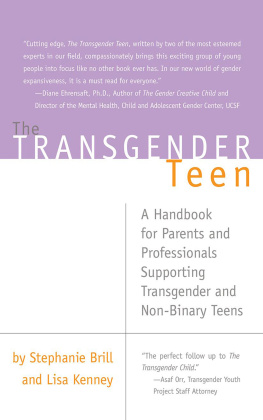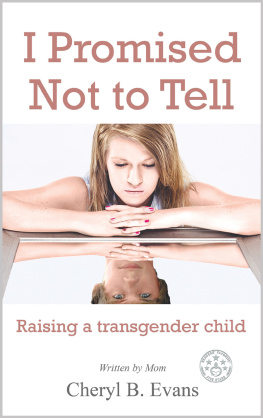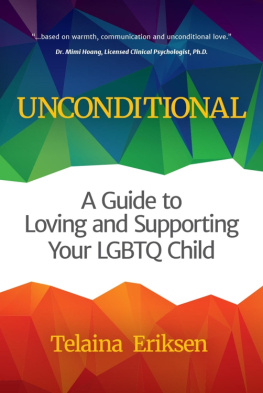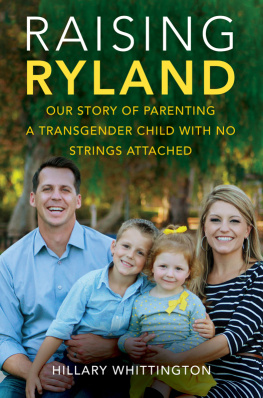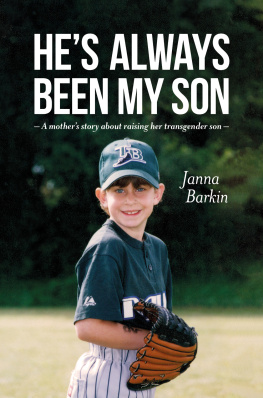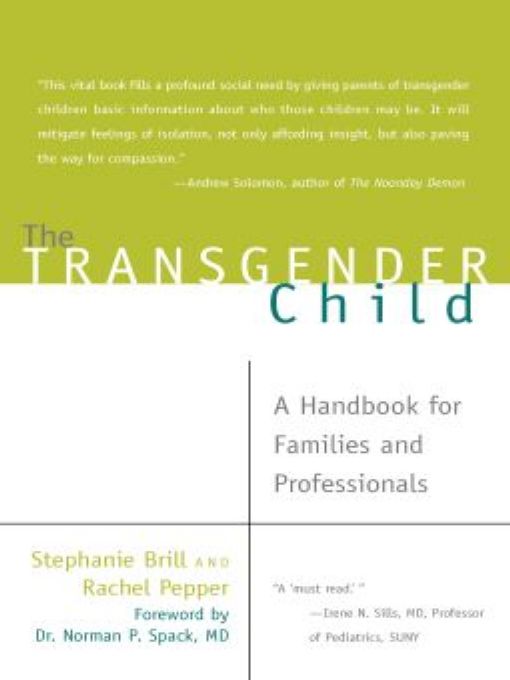Table of Contents
A must read for the families I see. I will suggest that parents provide copies to their school nurses and administrators. I will also recommend it to my colleagues in pediatrics and adolescent medicine. As a pediatrician, I find no greater pleasure than helping children grow and develop into happy, healthy, well-adjusted adults. This resource will help me in that goal for gender-variant and transgender youth.
Irene N. Sills, MD, Professor of Pediatrics, SUNY - Upstate Medical University, Joslin Center for Diabetes and Endocrinology
Gracefully, sensitively, and thoroughly illuminates a topic that has been shrouded far too long in fear and ignorance. Anyone who knows or loves a transgender child must read this book.
Jamison Green, author of Becoming a Visible Man
For far too long parents, families, friends, teachers and helping professionals have lacked a unified resource to help them navigate a reality that can be perplexing and challenging. The Transgender Child provides technical information, supportive resources, and personal stories that will positively impact the lives of transgender adolescents, children and their families. It will play the role of a practical companion on a journey that can be trying but also rewarding. The needs of transgender and gender-variant youngsters and their families are multiple, complex, and varied. Providing up-to-date and balanced information about a field of knowledge that is underdeveloped is not an easy task. With a clear commitment to improve the lives of transgender children and their families, Stephanie Brill and Rachel Pepper have achieved an inclusive and concise reading that is a must have for all those involved.
Edgardo Menvielle, MD, Associate Professor of Psychiatry and Behavioral Sciences, The George Washington University, Director of the Gender and Sexuality Psychosocial Programs, Childrens National Medical Center
A great, practical guide that every parent should read. Parents, teachers, grandparents, and anyone who interacts with kids on a regular basis will find The Transgender Child to be a smart, accessible roadmap for what can often be an uncharted journey. Stephanie Brill and Rachel Pepper help parents cut to the chase so they can do what every parent does best: love and embrace their child, no matter who they are.
Jody M. Huckaby, Executive Director of PFLAG
This beautifully written, meticulously well-researched book is a godsend for parents and professionals in search of clear, reliable, and up-to-date information about all facets of parenting and caring for transgender children. Combining real-life experience with the latest research, Stephanie Brill and Rachel Pepper have written an indispensable guide that will save lives and empower families to ensure that transgender children receive the love and support they need to thrive.
Shannon Price Minter, Legal Director, NCLR
Stephanie
For Aidanmy visionary playmate
Rachel
I dedicate this book to all the children who teach us about love and life every day, especially my own private tutor, Frances Ariel.
Foreword
Autobiographical, sociological, and psychological books and novels about transgenderism abound. While the autobiographers often painfully recount their earliest gender discomfort, there is little evidence of their having received proper evaluation, counseling, or support. Early medical intervention is absent. Until the advent of the Internet, parents of transgender children were convinced that they were the only parents on the planet confronting the conundrum of gender identity variance in the face of their childs consistent genotypic, phenotypic, and biochemical sex.
When their gender-variant behavior became obvious to the immediate and extended family, neighbors, classmates, and school personnel, most children were subject to ridicule, verbal bullying, and physical abuse. Parents were advised to redirect their childrens gender behavior or to restrict their access to the variant clothes and toys to a single room in the home and not to express atypical gender behavior elsewhere in word, dress, or behavior. Evidence for this approach is limited to just a few longitudinal studies claiming that less than 20 percent of gender-variant children will become transgendered adults. Mostly boys were studied and the majority were later defined as gay. These studies have been questioned because the subjects were gleaned from clinics overflowing with other psychological comorbidities. Nevertheless, the question is how to help the 8-to-10-year-old child who has been digging in their heels for five years or longer about their gender identity and gender role and is terrified about the prospect of puberty.
Despite the reality that gender identity disorder remains a DSM-IV psychiatric diagnosis, and though most major metropolitan areas have numerous mental health specialists skilled in the evaluation and counseling of late teens, young adults, and adults, precious few are competent to deal with preadolescents or their parents. Despite the tendency of pediatricians to refer complex issues such as gender variance in young children to child psychiatrists who have the most lengthy training, few have had any experience with primary gender identity disorders. Many are inclined to focus on and treat the presenting symptoms of depression and anxiety rather than the underlying gender conflict, and they frequently label the childs mood disorder as bipolar.
If there are few competent mental health professionals for the young gender-variant child, there are even fewer pediatricians, adolescent specialists, or pediatric endocrinologists familiar with the pharmacologic methods of pubertal suppression and the administration of crosshormones, the sex steroids of the affirmed gender. Only recently has the subject of gender identity issues not linked to Disorders of Sex Development (formerly known as intersex) become a topic for discussion in pediatric and endocrinology academic meetings in North America. In western Europe, it is already on their agenda.
Pediatric endocrinologists are the specialists most familiar with the medications and hormones that retard or accelerate puberty, and these specialists play a pivotal role in the painful decisions about medical and surgical intervention consequent to the evaluation of the child whose genitals are ambiguous or variable. In some cases, a gender may be assigned that is at variance with the genotypic or gonadal sex. Several notorious cases in the past two decades reached the general public and had long-lasting influence on physicians attitudes, because several young adults affirmed their genotypic gender identity and reversed their assignment. Criticism by adult former patients, some of whom formed their own support network, of their earlier treatment made pediatric endocrinologists and urologists defensive, and many questioned their ability to make decisions about these infants. Unable to hide from consultations on genital ambiguity, endocrinologists were even more reluctant to wade into the murkier waters of gender identity disorder, particularly when it was regarded as a psychiatric condition. Most hoped that the patients would remain in psychiatric care until they grew old enough to be treated by internal medicine-endocrinologists, who treat transgendered patients hormonally.


